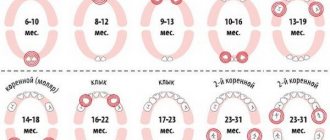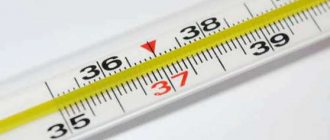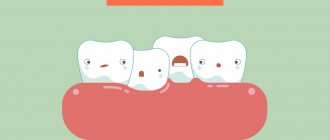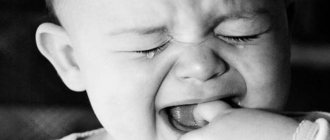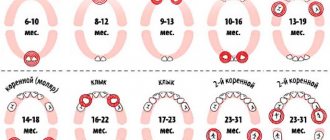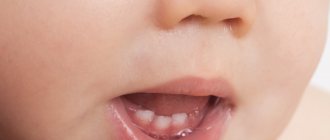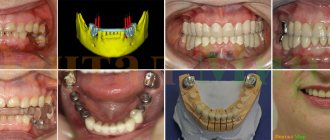When does a child's molars come out?
The eruption of a child’s molars is one of the most important periods in the development of a child’s body. It is quite painful, so parents need to be prepared for it and know when their baby’s molars begin to cut.
The first milky shoots are usually formed within 2 years, there are 20 of them in total. As already mentioned, among them there are two pairs of molars. The exact time when the first molar teeth begin to erupt has not been established. This depends on many factors: diet, heredity, climatic conditions of the region of residence, and the quality of drinking water.
If we talk about the first molars, they appear in the baby at the age of 12-17 months. Even if this process is delayed in your case, there is no need to worry. By the 32nd month they will definitely thin out. Second molars begin to erupt at 24-33 months, and the process is completed by 38-48 months. It must be taken into account that the growth and development of each child is individual. This also applies to teething. Even if the timing of the eruption of your child’s first molars is delayed or, conversely, they appear earlier in him than in his peers.
The growth of baby teeth usually stops by the age of three. By the age of five or six, the first signs of their change to radical ones begin to appear (in some children later). The entire process of formation of permanent teeth ends by the age of 12-14 years.
Types of teeth and their location
The lower and upper teeth of the six are dentin (the hard part of the tooth) with a cavity, covered with a layer of enamel. It has a characteristic shape, is built from several special tissues, and also has its own nervous system, circulatory and lymphatic system. Inside the tooth cavity, contrary to general belief, there is loose tissue permeated with nerves and blood vessels.
Normally, a person has from 28 (full set) to 32 teeth (full set + 4 wisdom teeth). Each tooth has its own name and performs a specific function.
Incisors are teeth whose function is to bite food. These are the front teeth that erupt first (4 at the bottom, 4 at the top).
Fangs are cone-shaped teeth, the functions of which are to tear and hold food (2 below, 2 above).
Premolars are small milk teeth, and then small molars, following the canines, a pair on each half of the jaw. There are 4 at the bottom, 4 at the top. This is the 1st, 2nd premolar, or if you give serial numbers - the 4th and 5th tooth.
Molars are teeth whose functions are the primary mechanical processing of food. These are the largest molars. They are located next to the premolars, a pair on each half of the jaw (4 below, 4 above). 1st and 2nd molars or teeth six and seven. If in adulthood, after 20 years, an additional molar or wisdom tooth is formed, then their number becomes 6 at the bottom and 6 at the top. The wisdom tooth is the 3rd molar or the number eight tooth.
Sixes, as well as 7s and 8s, do not have milk teeth. They erupt immediately as radicals.
If today many have seen what a separate molar six looks like from a photo on the Internet, then few know in what order the entire bite is located and what place this molar occupies.
Based on their type, teeth are divided into primary and permanent teeth.
In the temporary primary dentition of children, there are only 20 teeth: these are all 8 incisors, 4 canines, and 8 premolars.
In the permanent dentition there are 20 replaced and 8 original molars, for a total of 28: these are 8 incisors, 4 canines, 8 premolars and 8 molars immediately cut through by the molars. An additional 4 molars – wisdom teeth – may also appear. Then the bite will have 32 teeth.
Molars are being cut: symptoms
The first characteristic symptom of the beginning of the eruption of molars in a baby is that his jaw begins to increase in size. If the gaps between the baby teeth are quite small, then the body prepares to replace them with permanent ones - it creates all the necessary conditions for the growth of “adult” teeth.
The first molars announce their appearance quite seriously. This period brings the most pain to children and troubles to parents. The child sleeps poorly, becomes capricious, irritable, and may lose his appetite. Symptoms of molar teething may include a runny nose or cough, or an increase in the baby’s body temperature. According to doctors, these are not obligatory signs of eruption of molars; to a greater extent, they appear against the background of a general decrease in immunity and an increase in the vulnerability of the child’s body.
But, in any case, once the child reaches one year of age, parents should carefully monitor the child’s condition, the appearance of the symptoms described above, and act competently to relieve the baby’s unpleasant pain.
An almost obligatory sign of eruption of molars is increased salivation. At the second stage of tooth formation, this symptom is not as pronounced as the first time, but it can also cause inconvenience. By the age of 6-7 years, a child can already be taught to wipe his mouth and cheeks on his own, with a handkerchief or sterile napkins. If this is not taken care of, irritation will appear on his lips, cheeks and chin due to the increased sensitivity of the delicate baby skin (there are many different bacteria in saliva).
The eruption of molars in a child may be accompanied by symptoms such as diarrhea for several days. In this case, loose stools are a consequence of an infection entering the child’s body. The reason for this is that the baby often puts dirty hands or other objects into his mouth; copious salivation contributes to this, regularly washing the intestines. Short-term diarrhea (no more than three times a day) without the admixture of blood bodies is not dangerous for the child. But a doctor’s supervision will not be superfluous, since during this period, with a weakened child’s immune system, a new infection may be added and all symptoms may worsen.
Tooth structure
The teeth are located on the upper and lower jaws. They consist of hard and soft tissues.
Solid:
- tooth enamel – the outer shell that protects the tooth;
- dentin – hard tissue, the basis of the entire tooth;
- Dental cement is the tissue covering the neck and root of the tooth.
The soft pulp includes the loose tissue inside the dental cavity, which has a large number of vessels, both blood and lymphatic, and nerve endings.
Anatomically, a tooth can be distinguished into three parts:
- crown - the part protruding above the gum;
- root - a part located deep in the alveolus of the gum;
- neck of the tooth - part of the actual transition of the tooth enamel into cement, that is, the place in the gap between the root and the crown.
Parents helping their child when his molars are being cut
The process of erupting molars is long and painful. During these periods, parents should try to be very attentive and tolerant towards their baby. To reduce pain and anxiety, pediatric dentists recommend using special gels that are cooled in teethers.
If your temperature rises or alarming symptoms such as runny nose or cough appear, you should definitely consult a pediatrician. The doctor will determine the exact cause and may prescribe anti-inflammatory drugs.
Teething is a period when increased attention to oral hygiene is required. For this age, you need to choose the right toothpaste for your child. For example, children's toothpaste from the ASEPTA baby series for children aged 0 to 3 years significantly reduces the number of harmful microbes in the child's mouth, so that the difficult period of teething passes without unnecessary hassle.
Symptoms of molar eruption
As a rule, the sixth teeth emerge from the molars first.
During the teething period, the immune system's defenses are weakened, and the following symptoms similar to colds may appear:
- elevated temperature;
- runny nose;
- and most importantly – increased salivation.
And since the teeth appear in pairs, that is, the canine on the upper right side erupts at the same time as the canine on the upper left side, then the six teeth in children come out together, which can aggravate the process.
These teeth are the very first molars to erupt. To ease the symptoms of a small child and relieve some of the pain, you can massage the gums with your finger, but be sure to wash your hands thoroughly before doing so. Otherwise, it will not be difficult to get an infection. And older children can chew hard vegetables or fruits: apples, carrots and other hard foods.
You may also be interested in
CHILDHOOD
Finger wipes from 0 to 3 years ASEPTA BABY
For gentle oral hygiene of babies and massage of gums during the eruption of the first teeth
More about the product
CHILDHOOD
Children's gel toothpaste from 0 to 3 years ASEPTA BABY
Designed for gentle care of baby's gums and baby teeth
More about the product
How to motivate your child to brush their teeth
The variety of oral care products today is so great that teaching a child about dental hygiene has become much easier than before. Beautiful toothbrushes with favorite cartoon characters on the body, “delicious” toothpastes, mobile applications that turn brushing into a game - all this helps to develop pleasant associations. Brush your teeth together and praise your child for how well he does it.
Oral-B Vitality Kids Frozen D100.413.2K
Oral-B Pro 2 Junior Sensi Star Wars D501.513.2
Philips Sonicare For Kids HX6322/04 (HX6392/02)
Xiaomi Soocas Kids C1
Make sure that you spend at least two minutes brushing your teeth - place an hourglass on the sink, use a toothbrush with a built-in timer, or a special application on your smartphone.
An effective tool for caries prevention for children is plaque indicators. These are tablets and liquids that color the plaque in bright colors. This way, you can understand which areas need special attention when brushing and whether it’s time to contact a specialist, and the child will have a lot of fun looking at his multi-colored teeth. And he will probably want to repeat the cleaning with better results!
miradent Plaque Agent Plaque Indicator Rinse
Curaprox PCA 223 plaque indicator tablets
miradent Mira-2-Ton Plaque Indicator
miradent Plaque Check dental mirror
Take your child to a dental hygienist - clinics tell you well and clearly about how to care for your teeth and what will happen if you don’t. In addition, children are often motivated by themed cartoons. Show that you can take care of your teeth with pleasure - and the child will do it without unnecessary coercion.
All the most necessary hygiene products for children from 8 to 13 years old are collected in our children's set No. 3. It includes: an electric brush with Frozen or Star Wars cartoon characters, two toothpastes, preventive foam with calcium to strengthen enamel, chewing gum with xylitol and tablets for plaque indication. These are basic products that will help your child maintain healthy oral microflora and fight tooth decay.
Experts' opinion
The pleasant-tasting ASEPTA baby gel does not damage the milk enamel of teeth, has a beneficial effect on the gums, and plant extracts prevent the development of inflammation in the oral cavity. Thanks to the pleasant taste of “tutti-frutti”, toothpaste helps to develop the child’s daily oral hygiene skills. The paste does not contain fluoride or abrasives and is suitable for daily oral hygiene of a child.
An analysis of the clinical effectiveness of the use of various therapeutic and prophylactic agents of the Asepta series, carried out in Novosibirsk, at the State Budgetary Educational Institution of Higher Professional Education "Novosibirsk State University", confirmed that the line is different:
- Pronounced hygienic;
- Anti-inflammatory;
- Hemostatic property.
Sources:
- Study of the clinical effectiveness of the use of therapeutic and prophylactic agents of the ASEPTA series in the treatment of inflammatory periodontal diseases in children and adolescents (I.V. Klimova) Irina Vladimirovna Klimova, Candidate of Medical Sciences, Associate Professor of the Department of Pediatric Dentistry, Novosibirsk State Medical University. Department of Pediatric Dentistry, Novosibirsk State Medical University.
- Prevention of recurrence of localized periodontitis in young A.K. YORDANISHVILI, Doctor of Medical Sciences, Professor, North-Western State Medical University named after. I.I. Mechnikov, Military Medical Academy named after. CM. Kirov, International Academy of Sciences of Ecology, Human Safety and Nature.
- Article “Treatment and hygiene features for mild and moderate periodontitis” by S.B. Ulitovsky head Department of PFS, Professor, Doctor of Medical Sciences, A.A. Leontyev Associate Professor of the Department of PFS, Ph.D. PSPbSMU named after. I.P. Pavlova
Dental diseases
Parents need to remember one rule: if a child’s tooth starts to hurt, check number six first.
As they say, it is much easier to prevent any disease than to treat it later. The same applies to diseases of the teeth and oral cavity.
Six teeth above and below, despite their strength, are subject to both mechanical damage from physical effort and exposure to an acidic bacterial environment. And since all permanent teeth have nerve endings, any damage will cause pain, and most importantly, irreversible damage to the structure of the tooth, not to mention its possible loss.
If, due to tissue damage by some disease, it is necessary to remove tooth six, and this is the largest molar tooth, then in addition to the fact that the quality of chewing food will be impaired, an empty hole with a wound will remain, which will increase the likelihood of infection of the entire gum.
The most common dental disease is caries. This is a slow-moving process of bacterial activity affecting the tooth enamel, as a result of which they gain access to dentin and destroy it. In addition, since the path to the pulp, in which the vessels and nerves are located, is open, an infection can get there and cause inflammation of the internal tissues, pulpitis.
Tartar is not so much a disease as the result of improper brushing of teeth, as a result or absence of which, soft plaque begins to settle on the enamel, hardening over time, which makes it difficult to remove in the future. In most cases, it is not dangerous and can be removed in the dental office. However, it can cause inflammation of the gums - periodontitis. And if left untreated, superficial gum inflammation can develop into deep inflammation. And then your teeth will suffer.
Operation stages
The six implant is installed in the classical way, as for all other lost teeth. Includes stages:
Preparation
Identification of contraindications, assessment of bone tissue and study of its size and density. Sanitation of the oral cavity, removal of plaque, treatment of gums and adjacent teeth. The stage lasts from several days to a month.
Bone tissue augmentation
If necessary, it is carried out as a preliminary stage in case of lack of bone tissue. The operation lasts an hour. After the planted material has fused with the bone (4-5 months), the artificial roots themselves are installed.
Installation of implants
The gum is peeled off, a bed is formed in the bone, an implant is placed, a plug is fixed, and sutures are applied. On the lower jaw, the implant takes 2-4 months to take root, on the upper jaw - 4-6 months.
Temporary prosthetics
At the patient’s request, lightweight plastic removable Butterfly immediate dentures are installed, which are attached to adjacent teeth.
Permanent prosthetics
The implant is opened, the plug is removed, the gum former is fixed, and after 10-14 days the abutment is installed. Impressions are taken and crowns are installed.
The sixth tooth implant can be placed immediately after removal into the resulting socket, but with a sufficient amount of bone tissue and under the following conditions:
- a pre-planned operation with the possibility of conducting diagnostics and assessing the immediate installation of an implant;
- atraumatic removal without damaging the alveolar process;
- absence of inflammatory and purulent processes at the root.
